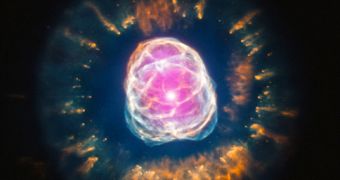Luckily for us, our sun still has a few billion years of life in it so it's safe to assume that most of us won't be around to see it go boom.
But if we were there to see it, or rather a safe distance away, we'd get quite the spectacle, as the image captured by NASA's Chandra X-Ray space telescope shows.
The image depicts the planetary nebula NGC 239, about 4,200 light-years away from Earth, also known as the Eskimo Nebula.
The nebula, despite its name, doesn't have anything to do with a planet and is in fact the remains of a star much like our sun that has run out of fuel.
"When this happens, the star begins to cool and expand, increasing its radius by tens to hundreds of times its original size. Eventually, the outer layers of the star are carried away by a thick 50,000 kilometer per hour wind, leaving behind a hot core," NASA explained.
"This hot core has a surface temperature of about 50,000 degrees Celsius, and is ejecting its outer layers in a much faster wind traveling six million kilometers per hour. The radiation from the hot star and the interaction of its fast wind with the slower wind creates the complex and filamentary shell of a planetary nebula," it added.

 14 DAY TRIAL //
14 DAY TRIAL //